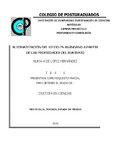Automatización del riego en arándano a partir de las propiedades del sustrato.
Abstract
El rendimiento y la calidad del fruto del arándano dependen en gran medida del sustrato, y de la aplicación suficiente y oportuna del riego, por esta razón se planteó que proporcionar el requerimiento hídrico en tiempo real, considerando las características del sustrato en el que se desarrolla, favorecería la productividad potencial del cultivo. Ergo, el objetivo general de este trabajo fue proponer un método de automatización del riego para la producción de arándano con base en las propiedades físicas del sustrato. Para poder alcanzar este objetivo se diseñó una metodología, que se dividió en dos fases. La primera consistió en la selección y generación de sustratos, y en la elaboración del algoritmo para automatizar el riego; y, la segunda en su implementación y evaluación bajo condiciones reales de invernadero, comparando el riego automatizado con un programa de riego diseñado a partir de la estimación de la ETo con el método empírico FAO Penman-Monteith. El diseño experimental fue completamente aleatorizado con un arreglo de 2 factores (tipo de riego y tipo de sustrato), obteniéndose 8 tratamientos y estableciéndose 6 repeticiones. La variable respuesta fue lecturas SPAD, por ser un indicador del vigor y vitalidad de las plantas de arándano. Los resultados mostraron que tanto la forma de aplicación del riego como el tipo de sustrato tienen efecto sobre el desarrollo de los arándanos, obteniéndose el mayor valor de lecturas SPAD en los tratamientos que corresponden al riego automatizado y al sustrato generado mediante la técnica de programación lineal Simplex Dual (70 % fibra de coco + 30 % tezontle). La innovación de este proyecto fue generar un prototipo único en su tipo para automatizar el riego de cultivos en sustrato, sin depender de algún método empírico ni de costosos y sofisticados instrumentos como los lisímetros de pesada. Se concluye que es posible automatizar los sistemas de riego para cultivo de arándano al corelacionar el contenido de humedad de los sustratos con la señal de los sensores capacitivos de humedad del suelo, favoreciendo la vigorosidad de las plantas. _______________ AUTOMATION OF IRRIGATION IN BLUEBERRY THROUGH SUBSTRATE PROPERTIES. ABSTRACT: The yield and quality of the blueberry fruit depend on the substrate, and on the sufficient and timely application of irrigation, therefore it was suggested that provide the water requirement in real time, considering the characteristics of the substrate in which it is developed, would benefit the potential productivity of the crop. Hence, the main objective of this work was to propose an irrigation automation method for the cultivation of blueberry based on the physical properties of the substrate. To achieve this objective, a two-phase methodology was designed. The first phase consisted in the selection and generation of substrates, and in the elaboration of the algorithm to automate irrigation. The second phase was the implementation and evaluation under real greenhouse conditions, comparing automated irrigation with an irrigation program designed with the empirical FAO Penman-Monteith method to estimate the EToThe experimental design was completely randomized with an arrangement of 2 factors (type of irrigation and type of substrate), obtaining 8 treatments and establishing 6 repetitions. The response variable was SPAD readings, as it is an indicator of the vigor and vitality of the blueberry plants. The results showed that both the form of application of irrigation and the type of substrate have an effect on the development of blueberries, obtaining the highest value of SPAD readings in the treatments that correspond to automated irrigation and the substrate generated by the Simplex Duañ linear programming technique (70% coconut fiber + 30% tezontle). The innovation of this project was to automate irrigation without relying on any empirical method, or on expensive and sophisticated instruments such as weighing lysimeters. In conclusion, it is possible to automate irrigation systems for blueberry cultivation by relating the moisture content of the substrates with the signal from the capacitive soil moisture sensors, favoring the vigor of the plants.
Collections
- Tesis MC, MT, MP y DC [349]


